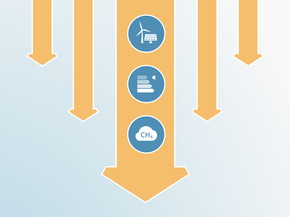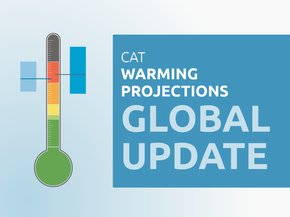Assumptions
Historical emissions
The historical dataset between 1990 and 2021 is based on PRIMAP National Historical Greenhouse Gas Emission Database 2022 (Gütschow, Günther and Pflüger, 2022). We took the 1994 and 2000 LULUCF values from the GHG emissions profiles for Non-Annex I countries (UNFCCC, 2015), the 2011 LULUCF value from Nepal’s GHG inventory for the Third National Communication (Tribhuvan University, 2019), and the 2019 LULUCF value from Nepal’s LTS 2021.
NDC and other targets
Nepal's unconditional NDC target is an activity-based target for the energy sector i.e. add 5 GW of clean energy generation by 2030. We assume that the clean energy generation from the unconditional target would cover more than just electricity generation e.g. emissions reductions from switching to EVs or electric stoves. Given that the unconditional target does not provide an absolute emissions reduction target and the assumption that the unconditional target covers the whole energy sector, the CAT cannot quantify this target. Instead, the CAT uses current policy projections.
The NDC provided limited details on some of the sectoral targets, so it was not possible to estimate the impact of all of them. In particular, the first ‘energy generation’ target (expand clean energy generation from 1.4 GW to 15 GW) and the second target for the transport sector (develop 200 km of the electric rail network) were not quantified. This means the total reduction under the conditional NDC could potentially be higher than our estimates. The second NDC also includes separate targets for the forestry sector but these are not included in our calculations as the CAT assesses NDCs without emissions from the forestry sector.
Some of the conditional targets from the second NDC are:
- Energy generation: (1) by 2030, expand clean energy generation from approximately 1.4 GW to 15 GW, of which 5-10% will be generated from mini and micro-hydro power, solar, wind and bio-energy (not included in the CAT calculations), (2) by 2030, ensure 15% of the total energy demand is supplied from clean energy sources.
- Transport: by 2030, increasing sales of e-vehicles to cover 90% of all private passenger vehicle sales including two-wheelers and 60% of all four-wheeler public passenger vehicle sales. This target will reduce emissions by 1.1 MtCO2e from a projected BAU, which is around a 28% decrease in emissions.
- Residential: (1) by 2025, Nepal aims to install 500,000 improved cookstoves specifically in rural areas, (2) by 2025, install additional 200,000 household-biogas plants and 500 large scale biogas plants, (3) by 2030, ensure 25% of households use electric stoves as their primary mode of cooking. These three combined targets will reduce emissions by 0.5 MtCO2e from a projected BAU, which is around a 23% decrease in emissions.
- Waste: by 2025, 380 million liters/day of wastewater will be treated before being discharged, and 60,000 cubic meters/year of fecal sludge will be managed. These targets will reduce emissions by 0.28 MtCO2e from a projected BAU.
Given that not enough data was provided in the NDC to allow us to calculate an economy-wide BAU, we assumed the ‘BAU scenario’ as referred to in the NDC submission, to be the same as the ‘pre COVID-19 current policy projection’ which were estimated through harmonising 2019’s historical emissions (exclude LULUCF) with growth emissions' estimates from Nepal’s 2nd National Communication.
The pre-COVID19 current policy projection maximum value upper range is using ‘NC2 Medium Growth (MG) scenario’ harmonised to 2019 emissions and is then used for the upper end of the BAU range for the conditional NDC. Meanwhile, the pre-COVID19 current policy projection minimum value uses ‘NC2 BAU scenario’ harmonised to 2019 emissions and is then used for the lower end of the BAU range for the conditional NDC.
We estimated a range for the conditional NDC as follows:
- Conditional NDC upper end of the range: Taking into account only the emission reduction estimated for actions in the transport, residential and waste sectors. The assumption is that the reductions reported in the NDC for electrification in the transport and residential sectors already reflect the change in the energy mix (target of 15% energy demand from clean sources) and therefore the associated emissions reduction. Thus, the NDC could reduce emissions by 1.9 MtCO2e in 2030, compared to BAU.
- Conditional NDC lower end of the range: Taking into account only the emission reduction from the second target for the ‘energy generation’ sector (15% of the total energy demand to be supplied with clean energy) and the reductions from the waste sector. The assumption is that the emissions reduction reported for transport and residential sector in the NDC represent only a part of the impact of this target and are included in the overall reduction calculated for the 15% target. We also assume that all clean energy would have an emission factor of zero MtCO2e. Under these assumptions, we estimate that the NDC could reduce emissions by 3.8 MtCO2e in 2030.
We assume Nepal is applying GWP values from the Second Assessment Report (SAR), in line with its previous National Communications and NDC submission. We have converted these values into those from the Fourth Assessment Report – as those are the values used across all CAT assessments.
Current policy projections
The current policy scenario is based on projections from Nepal’s Long-term Strategy 2021 for CO2 emissions from the energy, industry, agriculture and waste sectors (Government of Nepal, 2021); and EPA projections for non-CO2 emissions (EPA, 2019). The LTS sketches emissions value in the WEM (With Existing Measures) and the WAM (With Additional Measures) scenarios. We based the calculations only on the with WEM scenario. We used interpolation to complete the series from 2019 to 2050. Then, the WEM scenario was harmonised to historical data from PRIMAP 2022 is used for current policy scenario.
Net-zero target and other long-term targets
The CAT calculates Nepal’s target of achieving carbon neutrality by 2045 using the WAM (With Additional Measures) scenario stated in its Long-term Strategy. The WAM scenario covers only CO2 emission for each sector and projects a LULUCF sink of 10 MtCO2 in 2045.
To quantify a target in 2045 covering all GHG emission, we add our estimate of non-CO2 to the projected CO2 emissions excluding LULUCF from the LTS’ WAM scenario. We estimate non-CO2 emissions in 2045 by taking historical non-CO2 emissions from 2020 and applying the growth rate from the EPA’s BAU projections for non-CO2 emissions until 2045 (EPA, 2019; Gütschow, Günther and Pflüger, 2022).
The LTS’ WAM scenario uses GWP values from the Fifth Assessment Report (AR5), but the projection covers only CO2 so an AR5 to AR4 conversion is not necessary.
Global warming potentials
The CAT uses Global Warming Potential (GWP) values from the IPCC's Fourth Assessment Report (AR4) for all its figures and time series. Assessments completed prior to December 2018 (COP24) used GWP values from the Second Assessment Report (SAR).
Further analysis
Latest publications
Stay informed
Subscribe to our newsletter




